
Diffusion models play a role in color representation in image generation, driving a new era of generative models. Large models such as Stable Diffusion, DALLE, Imagen, and SORA have sprung up, further enriching the application background of generative AI. However, current diffusion models are not perfect in theory, and few studies have paid attention to the problem of undefined singularities at the endpoints of the sampling period. In addition, the average gray level caused by the singularity problem in the application and other problems that affect the quality of the generated image have not been solved.
In order to solve this problem, the WeChat vision team cooperated with Sun Yat-sen University to jointly explore the singularity problem in the diffusion model and proposed a plug-and-play method to effectively solve it. The sampling problem at the initial moment is solved. This method successfully solves the average gray level problem and significantly improves the generation ability of existing diffusion models. This research result has been published at the CVPR 2024 conference.
Diffusion models have achieved remarkable success in multi-modal content generation tasks, including image, audio, text, and video generation. The successful modeling of these models mostly relies on the assumption that the inverse process of thediffusion process also conforms to Gaussian properties. However, this hypothesis has not been fully proven. Especially at the endpoint, that is, t=0 or t=1, the singularity problem will occur, which limits the existing methods to study the sampling at the singularity.
In addition, the singularity problem will also affect the generation ability of the diffusion model, causing the model to have anaverage grayscale problem, that is, it is difficult to generate images with strong or weak brightness. As shown below. This also limits the application scope of current diffusion models to a certain extent.
In order to solve the singularity problem of the diffusion model at the time endpoint, the WeChat visual team cooperated with Sun Yat-sen University and conducted in-depth research from both theoretical and practical aspects. First, the team proposed an error upper bound containing an approximate Gaussian distribution of the inverse process at the singularity moment, which provided a theoretical basis for subsequent research. Based on this theoretical guarantee, the team studied sampling at singular points and came to two important conclusions: 1) The singular point at t=1 can be transformed into a detachable singular point by finding the limit, 2) The singularity at t=0 is an inherent property of the diffusion model and does not need to be avoided. Based on these conclusions, the team proposed a plug-and-play method:SingDiffusion, to solve the problem of sampling the diffusion model at the initial moment.
It has been proven through a large number of experiments that the SingDiffusion module can be seamlessly applied to existing diffusion models after only one training, significantly solving the problem of average gray value. Without using classifier-less guidance technology, SingDiffusion can significantly improve the generation quality of the current method. Especially after being applied to Stable Diffusion 1.5 (SD-1.5), the quality of the images it generates is improved by 33%.
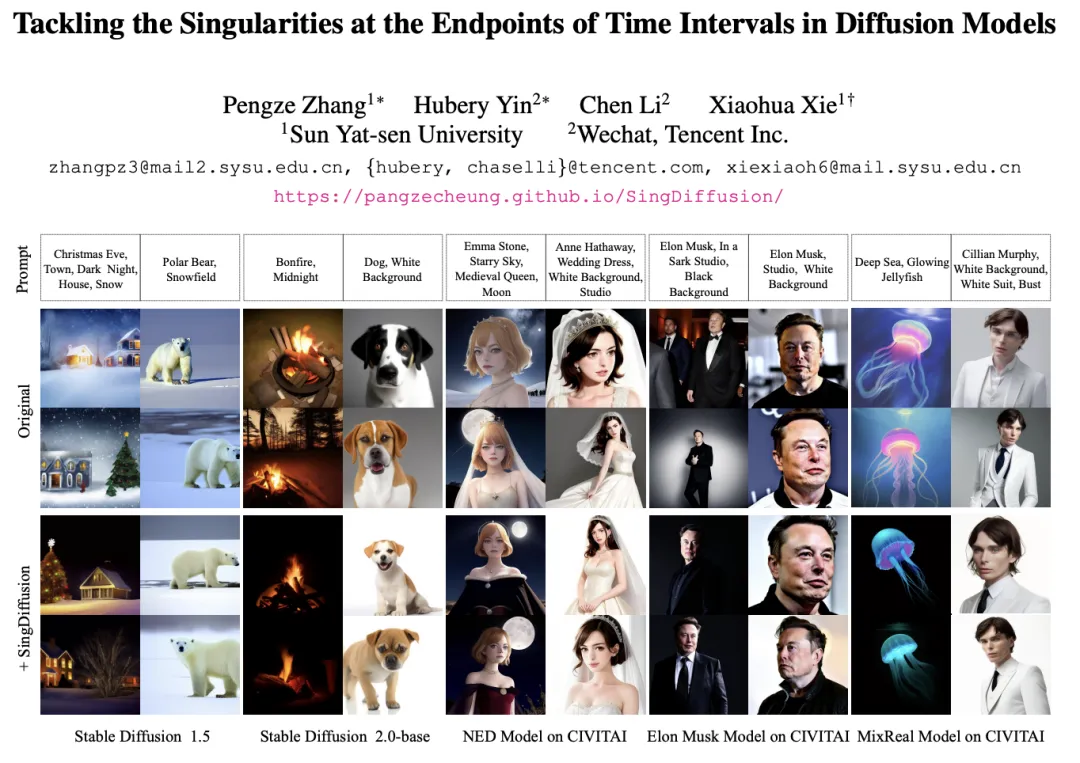
Paper address: https://arxiv.org/pdf/2403.08381.pdf
Project Address: https://pangzecheung.github.io/SingDiffusion/
Thesis title: Tackling the Singularities at the Endpoints of Time Intervals in Diffusion Models
In order to study the singularity problem of the diffusion model, it is necessary to verify that the inverse process at the singularity point in the entire process satisfies the Gaussian properties. First define as the training sample of the diffusion model. The distribution of the training sample can be expressed as:
as the training sample of the diffusion model. The distribution of the training sample can be expressed as:

where δ represents Dirac function. According to the definition of continuous time diffusion model in [1], for any two moments 0≤s,t≤1, the forward process can be expressed as:

Among them ,
, ,
, ,
, monotone over time changes from 1 to 0. Considering the training sample distribution just defined, the single-moment marginal probability density of
monotone over time changes from 1 to 0. Considering the training sample distribution just defined, the single-moment marginal probability density of can be expressed as:
can be expressed as:

## is given by Therefore, the conditional distribution of the inverse process can be calculated through the Bayesian formula:

However, the obtained distribution is a mixed Gaussian distribution, which is difficult to use the network to perform fitting. Therefore, mainstream diffusion models usually assume that this distribution can be fit by a single Gaussian distribution:

To test this hypothesis, the study estimates the error of this fitting in Proposition 1.

will also Approaching 1, the error cannot be ignored. Therefore, Proposition 1 does not prove the inverse Gaussian property at t=1. In order to solve this problem, this study gives a new proposition:

will approach 0. Thus, this study proves that the entire inverse process including the singularity moment conforms to Gaussian characteristics.
First consider the singularity problem at time t=1. When t=1,
=0, the following sampling formula will have the denominator divided by 0:

However, this limit cannot be calculated during testing. To this end, this study proposes that can be fitted at time t=1 and "x - prediction" can be used to solve the sampling problem at the initial singular point.
can be fitted at time t=1 and "x - prediction" can be used to solve the sampling problem at the initial singular point.
Then consider the time t=0, the inverse process of Gaussian distribution fitting will become a Gaussian distribution with a variance of 0, that is, the Dirac function:

in . Such singularities will cause the sampling process to converge to the correct data
. Such singularities will cause the sampling process to converge to the correct data . Therefore, the singularity at t=0 is a good property of the diffusion model and does not need to be avoided.
. Therefore, the singularity at t=0 is a good property of the diffusion model and does not need to be avoided.
In addition, the study also explores the singularity problem in DDIM, SDE, and ODE in the appendix.
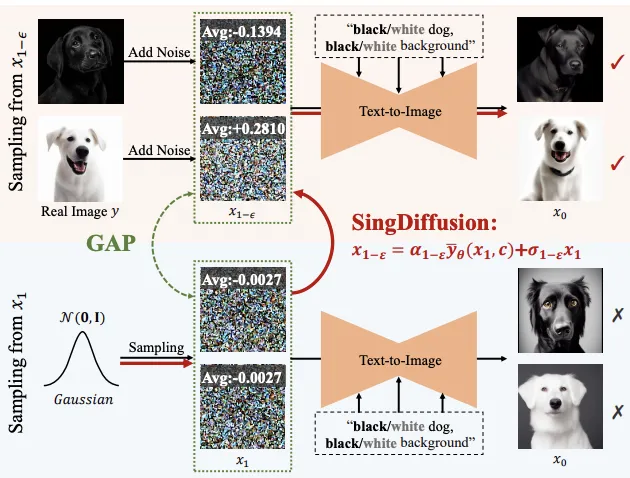
Sampling at singular points will affect diffusion model generation Image quality. For example, when inputting cues of high or low brightness, existing methods often can only generate images with average grayscale, which is called the average grayscale problem. This problem stems from the fact that the existing method ignores the sampling at the singular point when t=0, but uses thestandard Gaussian distributionas the initial distribution for sampling at the 1-ϵ moment. However, as shown in the figure above, there is a large gap between the standard Gaussian distribution and the actual data distribution at 1-ϵ time.

Under such a gap, according to Proposition 3, the existing method is equivalent to moving towards an image with a mean value of 0 at t=1 Generate, that is, an average grayscale image. Therefore, it is difficult for existing methods to generate images with extremely strong or weak brightness. To solve this problem, this study proposes a plug-and-play SingDiffusion method to bridge this gap by fitting the conversion between a standard Gaussian distribution and the actual data distribution.
The algorithm of SingDiffuion is shown in the figure below:

According to the conclusion of the previous section, this research The "x - prediction" method is used at time t=1 to solve the sampling problem at the singular point. For image-text data pair , this method trains a Unet
, this method trains a Unet to fit
to fit . The loss function is expressed as:
. The loss function is expressed as:

After the model converges, you can follow the DDIM sampling formula below and use the newly obtained module sampling
sampling .
.

The sampling formula of DDIM ensures that the generated conforms to the data distribution at 1-ε time
conforms to the data distribution at 1-ε time , thereby solving the problem of average grayscale question. After this step, the pretrained model can be used to perform subsequent sampling steps until
, thereby solving the problem of average grayscale question. After this step, the pretrained model can be used to perform subsequent sampling steps until is generated. It is worth noting that since this method only participates in the first step of sampling and has nothing to do with the subsequent sampling process, SingDiffusion can be applied to most existing diffusion models. In addition, in order to avoid data overflow problems caused by no classifier guidance operation, this method also uses the following normalization operation:
is generated. It is worth noting that since this method only participates in the first step of sampling and has nothing to do with the subsequent sampling process, SingDiffusion can be applied to most existing diffusion models. In addition, in order to avoid data overflow problems caused by no classifier guidance operation, this method also uses the following normalization operation:

where guidance represents the result after no classifier guidance operation, neg represents the output under negative prompts, pos represents the output under positive prompts, and ω represents the guidance strength.
First, the study verified SingDiffusion on three models: SD-1.5, SD-2.0-base and SD-2.0 The ability to solve the average grayscale problem. This study selected four extreme prompts, including "pure white/black background" and "monochrome line art logo on white/black background", as conditions for generation, and calculated the average grayscale value of the generated image, as shown in the table below Shown:
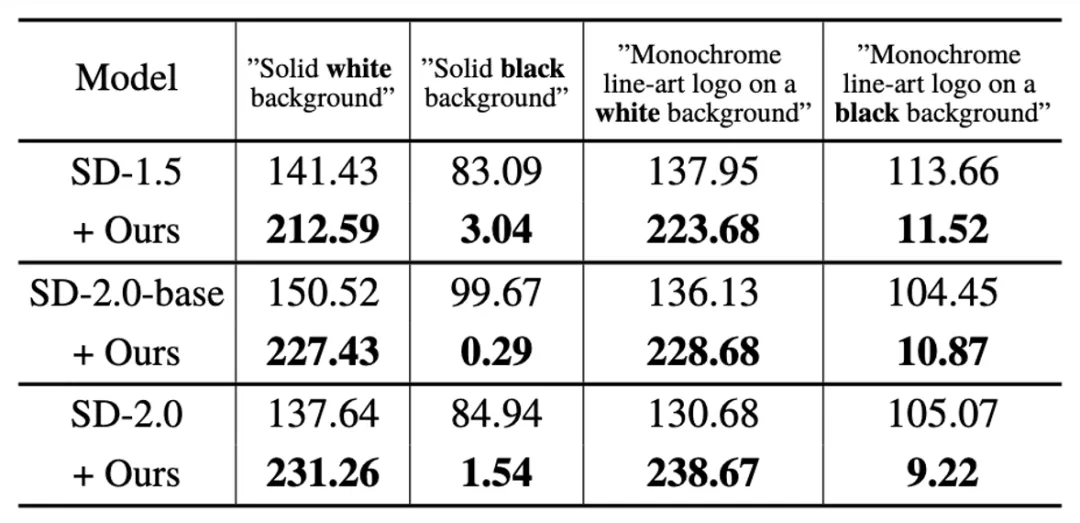
As can be seen from the table, this research can significantly solve the problem of average gray value and generate a color that matches the brightness of the input text description. image. In addition, the study also visualized the generation results under these four prompt statements, as shown in the following figure:
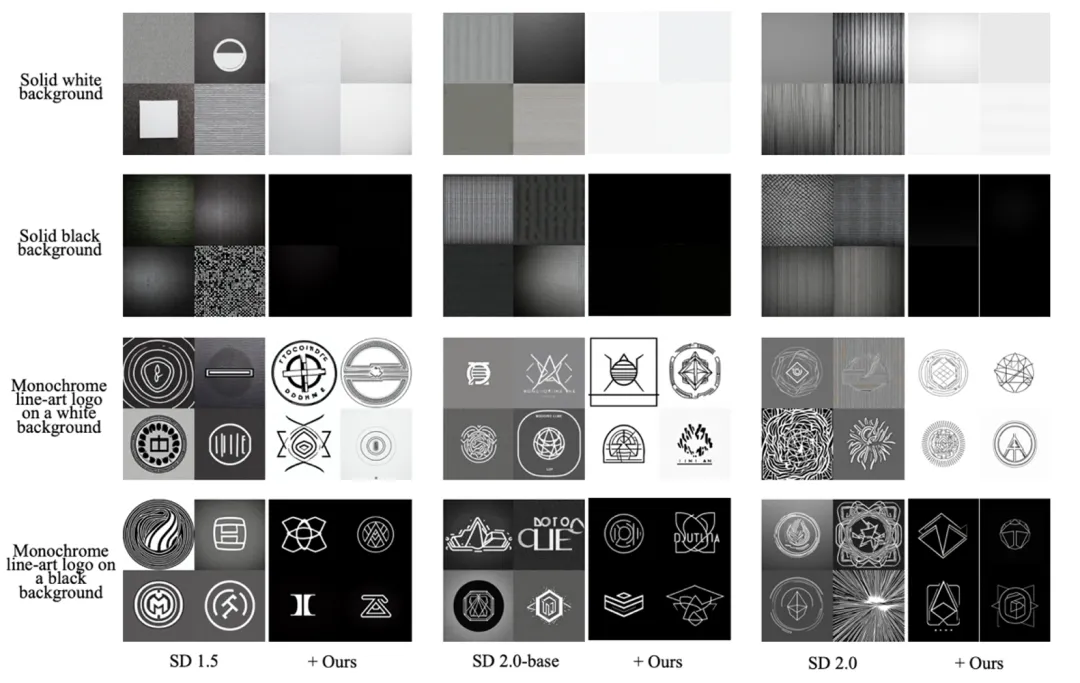
As can be seen from the figure , after adding this method, the existing diffusion model can generate black or white images.
To further study the improvement of image quality achieved by this method, the study selected 30,000 descriptions for testing on the COCO dataset. First, the study demonstrates the generative capabilities of the model itself without the use of classifier-free guidance, as shown in the following table:

From the table It can be seen that the proposed method can significantly reduce the FID of the generated images and improve the CLIP index. It is worth noting that in the SD-1.5 model, the method in this paper reduces the FID index by 33% compared to the original model.
Further, in order to verify the generation ability of the proposed method without classifier guidance, the study also shows in the figure below that under different guidance sizes ω∈[1.5,2,3 ,4,5,6,7,8] Pareto curve of CLIP vs. FID:
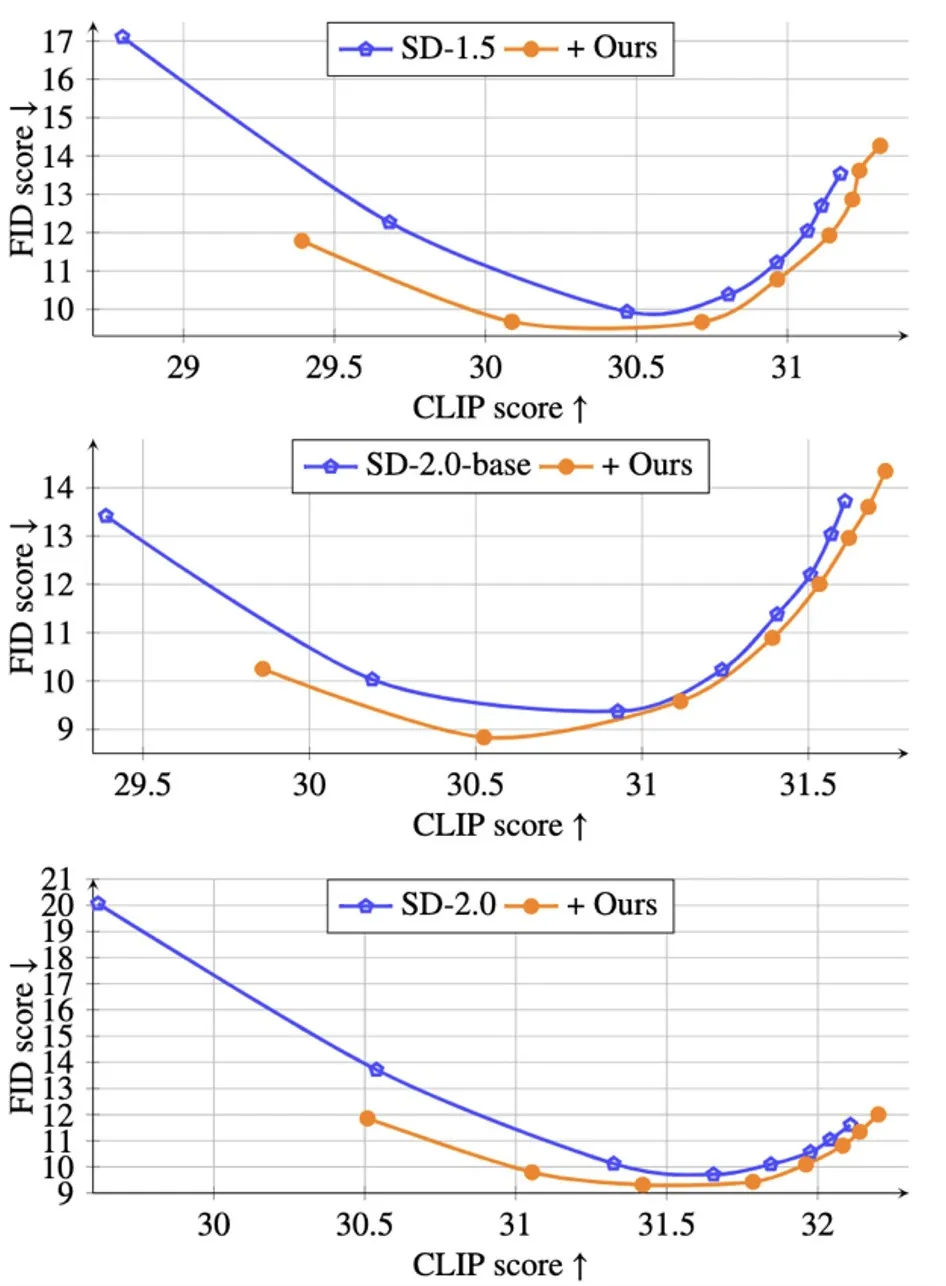
As can be seen from the figure, in At the same CLIP level, the proposed method can obtain lower FID values and generate more realistic images.
In addition, this study also demonstrates the generalization ability of the proposed method under different CIVITAI pre-training models, as shown in the following figure:
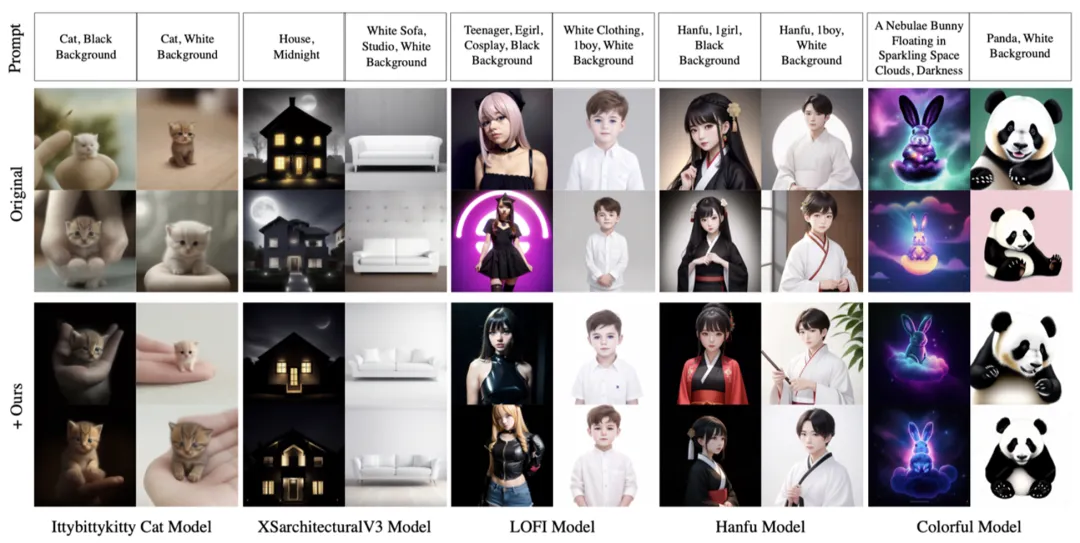
It can be seen that the method proposed in this study only needs one training and can be easily applied to existing diffusion models to solve the average grayscale problem.
Finally, the method proposed in this study can also be seamlessly applied to the pre-trained ControlNet model, as shown in the following figure:
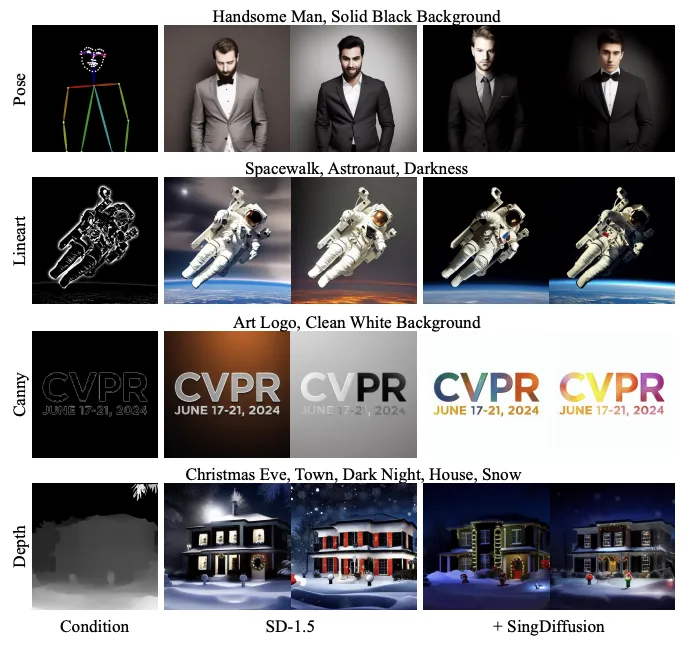
It can be seen from the results that this method can effectively solve the average grayscale problem of ControlNet.
The above is the detailed content of Can't generate a picture with extremely strong light? WeChat Vision Team effectively solves the singularity problem of diffusion model. For more information, please follow other related articles on the PHP Chinese website!




